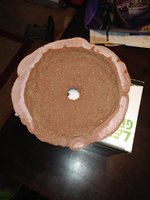@BonsaiJames1986
Plan on joining the Milwaukee Bonsai Society. They just had a zoom meeting, and once outdoor activities are tolerable, will be meeting outdoors. It is an active club, with a good mix of members, from 15 to 80+ years old. Not just old fogeys. It is a good active club, and Covid permitting, will be hosting the Mid America Bonsai Association Convention in autumn 2021.
I used to work in the concrete industry, making chemicals to modify concrete. Our projects were mostly "big", think bridge decks, buildings over 50 stories, confinement vessels for nuclear power plants. The "better" product for small pots is concrete patching compound for VERTICAL patches. There are many product names that fit. Key words to look for are "vertical patching", "thin applications". These products will be a hybrid of portland cement, and a plastic polymer, either vinyl or acrylic polymer. The resulting cement paste will be more resistant to cracking. In addition, you can add plastic fibers, they look like polyethylene bow ties, these are mixed into the paste. These work in a way similar to internal frames and armatures, in terms of providing support against flexing. Concrete, has incredible compressive strength, but really poor flexural strength. I have played with credit card thickness fletches of concrete made with these hybrid cementitious-vinyl polymer blends, and they are almost as flexible as a credit card. Those were R & D lab samples. The commercial cementitious-polymer blends you can find at Home Depot won't finish that flexible. But cracking due to flexing is a big problem with concrete pots. The flexible concrete made for patching in thin applications will go a long way to making a better concrete pot. (thin in the concrete world is less than 4 inches or 10 cm).
In Southeast Asia, Viet Nam, Malaysia, Indonesia, etc, they use concrete pots almost exclusively. But, the pots they make are BIG. Because all their bonsai is intended to be grown and displayed outdoors, and outdoors only, their pots tend to be quite large, and as a result weight hundreds of pounds. But you can look at Indonesian & Vietnamese website to get inspiration.
Maturing concrete before use. After the concrete is set, just soak it in a bucket of water for a month. Change the water once or twice. This should leach and excess calcium hydroxide out. This is probably not necessary for use as a bonsai pot, the amount of leaching is not very high, but if the pot will come in contact with your goldfish pond, it is important to leach the pot.
A good all purpose concrete sealer is linseed oil, you can buy it at a paint store, or paint department of a big box. Allow the pot to dry a couple weeks, then paint it with the linseed oil. If it looks dry after the first coat, apply a second coat. The linseed oil will seal the pores, making the concrete more freeze-thaw resistant, and protecting the soil from leaching from the concrete.
 just some cement pots I am making. First time so its all trial by error. They are turning out and I think will be usable. I am using portland cement and sand1 to 3 ratio respectively. Still trying to research on leaching the cement and sealing. From what I'm reading these pots wont be safe to us for a month.
just some cement pots I am making. First time so its all trial by error. They are turning out and I think will be usable. I am using portland cement and sand1 to 3 ratio respectively. Still trying to research on leaching the cement and sealing. From what I'm reading these pots wont be safe to us for a month.




